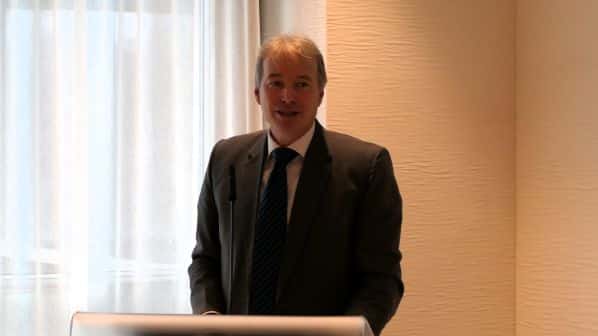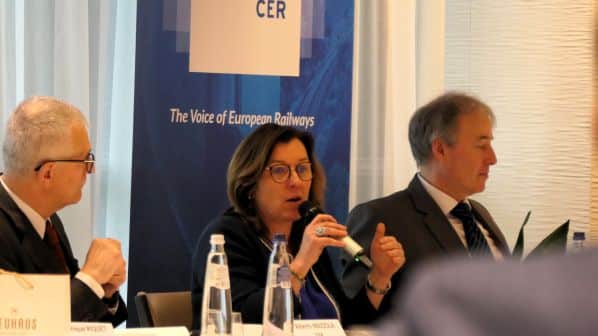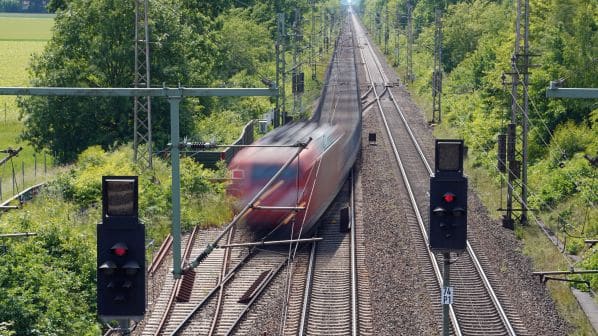AS it works to implement the European Union’s (EU) Sustainable and Smart Mobility Strategy, the European Commission (EC) is clear that the current patchwork of national systems for allocating and managing rail capacity is a major obstacle to meeting EU modal shift objectives.
It is especially true in the case of rail freight where the aim is to increase traffic by 50% by 2030, and double it by 2050. The current situation is “suboptimal,” according to Mr Kristian Schmidt, director of land transport at the EC’s Directorate General for Mobility and Transport (DG-Move). “Capacity allocation is undertaken annually, manually and nationally,” he says. “We need to become European, digital and flexible in order to save rail freight because it is 50% cross-border and it won’t succeed in delivering modal shift if it is last in the capacity allocation queue.”
Schmidt spoke on January 23 at a debate organised by the Community of European Railway and Infrastructure Companies (CER) at the European Parliament in Brussels, which brought together the EC, MEPs and the rail sector to consider the EC’s proposed regulation on the use of rail infrastructure capacity.
The EC is reforming capacity management by means of a regulation which, unlike an EU directive, does not need to be transposed into national law and is directly applicable after its entry into force. “It is a legally binding framework forcing infrastructure managers to cooperate, not just expressing that it would be nice to do so,” Schmidt says. “There is a very strong obligation.”

Mobility and Transport (DG-Move)
At the same time, Schmidt believes that, far from being a power-grab on the part of the EC, the new regulation will actually empower Europe’s infrastructure managers and enable them to better meet the needs of cross-border freight, international passenger services and Europe’s emerging new generation of overnight trains. “What we’re suggesting is a model where the infrastructure managers stay responsible for their networks,” Schmidt says. “But there is a European legal framework, obliging them to coordinate, to make it work, and to make it work for [each] market segment.”
Alongside greater coordination, the EC wants infrastructure managers to make greater use of digital tools in order to make the process of obtaining train paths faster, simpler and more flexible, and enabling both infrastructure managers and rail freight operators to respond better to market trends. “There is an obligation to come together and build a common digital tool so that, ideally, as a customer or a shipper, with one click you can reserve your train paths from A to B across borders in Europe,” Schmidt says. “If we don’t get that, we won’t be able to save rail freight.”
Overall, the measures contained in the proposed regulation are expected to deliver a 4% increase in capacity, which according to the EC’s impact assessment would be able to accommodate an additional 250 million train-km, generating economic value of €2.5bn for operators. “The 4% is not negotiable,” Schmidt says. “If you were to provide 4% additional capacity by building new infrastructure, it would take you many years to get this done. And we have also calculated that it will cost you €8bn to build what we could release in additional capacity just by managing what we have better.”
Freight focus
Better capacity management and streamlined processes form part of the toolkit for meeting rising demand, as Mr Johann Pluy, CEO of Austrian infrastructure manager ÖBB Infrastructure, points out.
Demand on Austria’s national network is expected to increase by 30% over the next 10 years and would be difficult to meet through new construction alone “which takes too long,” according to Pluy.
“Let me be clear,” he says. “We need this regulation to reach the next level,” pointing to capacity management that at present is conducted nationally using Excel spreadsheets and based on communication by phone, fax and email. “This is not the right way to arrive at the Single European Railway Area that we want,” Pluy says. “This regulation offers two things. This first is capacity strategy and modelling; we can plan and be more reliable. The second part is more operational, concerning incident management and allocating paths, which we need to digitise.”
“We need to become European, digital and flexible in order to save rail freight.”
Mr Kristian Schmidt, director of land transport at the EC’s Directorate General for Mobility and Transport (DG-Move)
“Last year there were 500,000 requests for short-term freight paths in Austria alone,” Pluy says. “This process must be digitised because we can’t handle that amount of data manually.”
When scaled up to the European level this becomes a sizeable challenge. “Market needs can be different according to our different customers,” said Mr Frédéric Delorme, CEO of French National Railways’ (SNCF) freight division Rail Logistics Europe (RLE) and its domestic operating business Fret SNCF.
Speaking on behalf of Rail Freight Forward, a European association of rail freight operators, Delorme says the EC initiative is welcome, “because clearly this regulation is much better than the Rail Freight Corridor regulation 10 years ago.”
Regulation (EU) No 913/2010 established the 11 European Rail Freight Corridors (RFCs) and their one-stop shops intended to make it easier to obtain paths for cross-border services. As the EC’s own evaluation of the RFC regulation found in 2021, this approach failed to deliver, as it narrowed the focus of coordination to individual corridors rather than the entire rail network, meaning that freight operators still needed to contact individual infrastructure managers if they wanted to secure paths outside the corridors. “Instead of simplifying the process, one-stop shops amounted to an additional administrative layer,” the EC says.
According to Schmidt, the RFC regulation “was conceptually wrongly conceived.”
“It’s probably no coincidence that infrastructure managers support the proposal that we have come up with, first of all because we listened very carefully to the infrastructure managers before drafting, but also because we learned from our past mistakes,” Schmidt says.
The new regulation will in fact repeal the RFC regulation and aims to address its other weaknesses, as identified by the EC evaluation, including the failure to harmonise national tools and procedures for capacity management, and not mandating the use of specific digital tools. While the RFC management boards were required to monitor performance, the evaluation showed that a number of important aspects, such as door-to-door punctuality, were neglected.
Performance review
The new regulation introduces a performance review framework, with the existing European Network of Infrastructure Managers (Enim) given the task of monitoring performance and publishing annual reports. A Performance Review Body will be created to provide advice and recommendations on performance-related matters.
“We need harmonised KPIs in Europe, we need good-quality data behind these KPIs, and when they are chosen they must be officially published, public, and followed up over time,” Delorme says. However, he is clear that this should not lead to more organisational complexity. “Don’t create a new body, we have enough bodies in Europe, but someone should be in charge of that. That’s my main message.”
“We’re not proposing any new bodies, that’s not what we need,” Schmidt says. “What we need is a very clear framework and the obligation to perform, to be close to the market, to be service-oriented.” However, Delorme is not alone in voicing sector concerns that the new regulation could increase the regulatory burden. “Let me provide some advice as a manager with 20 years’ experience of transformation processes: keep it simple,” Pluy says. “If we have too many players, there is a lot to do to bring the stakeholders together, it’s easy to say, but in reality it’s very difficult. So please streamline the governance, streamline the processes.”
“What we want is a transparent, equal, non-discriminatory decision-making process.”
Kristian Schmidt
Under the proposed regulation, the European framework for capacity management will be developed by a strengthened Enim, supported by a network coordinator. Rail Net Europe (RNE), an association of 38 European infrastructure managers, is now preparing to take on the role of network coordinator should it emerge as the candidate of choice as the text of the draft regulation is scrutinised by the European Parliament and later the European Council. RNE says that the network coordinator will also be involved in developing the performance review framework and the IT changes involved in implementing the regulation, placing emphasis on the development of stakeholder involvement processes.
However, one of the 629 amendments made by MEPs to the EC’s draft text proposes the creation of a new European Rail Infrastructure Capacity Allocation body, known as Erica. It would contribute to the preparation of the European framework for capacity management, as well as operational coordination between infrastructure managers, and would also facilitate the development and implementation of digital tools and services for capacity and traffic management.
The amendment creating Erica was put forward by Ms Tilly Metz MEP, appointed by the European Parliament’s Committee on Transport and Tourism to act as rapporteur on the draft regulation. Metz is responsible for collating amendments before preparing a final report that is adopted by the committee and then voted on in a plenary session of the parliament.
She says Erica should not be a new body but part of something that already exists, suggesting that it might form part of the European Union Agency for Railways (ERA). Erica would provide collective scrutiny and ensure that a pan-European approach is taken, as well as supporting the implementation of digital tools “because that’s also going to be very challenging and very important,” Metz says.

Believing that MEPs, the EC and the rail sector all have the same objective, she hopes that a compromise could be found on Erica, stressing that her intention is “not to make it more complicated” but more efficient.
Schmidt suggests that Erica should do “something else other than managing the capacity manager,” and that it should be responsible for monitoring performance. “That’s what the commission thinks we should truly have,” he says. “We should allow close collective scrutiny of our collective performance.”
Metz also proposes that Erica should support the development and application of the standardised socio-economic and environmental criteria that the draft regulation says should be applied by infrastructure managers to allocate scarce capacity when conflicting requirements for paths cannot be resolved by means of consensual conflict resolution.
These criteria include operating costs and the subsequent impact on prices for customers, time-related costs for customers, and the implications for the connectivity of the regions served. Emissions, noise and other external costs should also be taken into consideration, as well as the safety and public health implications of the proposed rail services and their likely alternatives.
“What happens mostly at present is that if there is a capacity conflict, freight is last, international is last, and local PSO commuter traffic is prioritised,” Schmidt says. “I can see some cases where this is justified, but I can also see how if that is always the case, we will never reach the targets for 2030 and 2050 that we have set ourselves. What we want is a transparent, equal, non-discriminatory decision-making process where these conflicts are resolved on the basis of informed choices and criteria.”
Test runs
According to Mr Klaus Garstenauer, chief operating officer at ÖBB Passenger, “we have to calibrate the socio-economic indicators for this common strategy so that we arrive at meaningful results when we apply them. And I think it would be advisable to have a couple of test runs before we get into the hard reality.”
This view was shared by Mr Dominique Riquet MEP, a shadow rapporteur on the capacity regulation. “I fear this arbitration will happen at the expense of commuters and long-distance passengers where freight and passenger trains operate on the same infrastructure,” he says. “For this reason, my proposal is to limit the scope of the socio-economic criteria, at least for some time, in order to be able to make an informed choice regarding their usefulness for the rail market.”
These new criteria and other issues remain to be resolved as the capacity regulation makes its way through the European legislative process. Nevertheless, once the Committee on Transport and Tourism has voted on its final report, Metz hopes the first reading of the amended draft text can take place in a plenary session of the European Parliament before its current mandate ends and the European elections are held on June 6-9. The indicative plenary session date is March 11, “but if that would not be possible you still have April,” Metz says.
If the text adopted by the parliament at its first reading is accepted by the European Council, made up of the heads of state or government of all 27 EU members, then the regulation would enter force. If not, a second reading might ensue, and possibly a third, after the appointment of a conciliation committee charged with agreeing a text that is acceptable to both institutions.
“We need to be careful because the proposal is not simple,” CER executive director, Mr Alberto Mazzola, tells IRJ.
While stressing that CER is supportive of the proposed regulation, he is concerned that if the text approved by parliament is not acceptable to the EU member states, then the initiative to improve rail capacity management could suffer the same fate as that attempting to establish the Single European Sky, which has been “blocked in the council for 10 years.
“If we get stuck on this point, then we lose the momentum of what this proposal can provide,” Mazzola says.
“We need to see what parliament’s position is,” Mazzola adds, hopeful that discussions between parliament and the council will be fruitful. “I sense that in both institutions the level of ambition is very, very high,” Schmidt says. “I think we needed this proposal yesterday. We took our time to finalise it, and we are at your side to make sure that you get this in operation as quickly as possible because the sector desperately needs it.”

